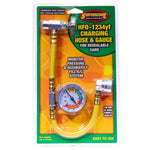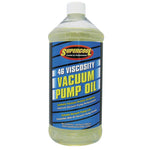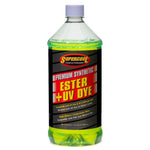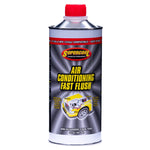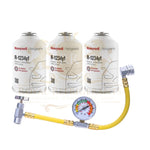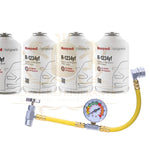You have no items in your shopping cart.
Everything You Need to Know About Hydrofluorocarbon 134A for HVAC and Automotive Applications
In the world of HVAC and automotive air conditioning, few refrigerants have had as much impact as Hydrofluorocarbon 134A (HFC-134a). Since its introduction in the early 1990s as a replacement for ozone-depleting CFC refrigerants like R-12, HFC-134a has become one of the most widely used refrigerants in the United States and around the world. Its balance of performance, safety, and cost-effectiveness has made it a mainstay in both residential cooling systems and vehicle air conditioners.
If you're an HVAC technician, automotive professional, or simply someone looking to understand more about refrigerants, this guide will cover everything you need to know about HFC-134a, including its properties, uses, environmental impact, safety considerations, and future outlook.
What Is Hydrofluorocarbon 134A?
HFC-134a, commonly referred to as R-134a, is a hydrofluorocarbon refrigerant with the chemical formula CH₂FCF₃. It is a single-component refrigerant known for its zero ozone depletion potential (ODP) and moderate global warming potential (GWP ~1430). R-134a operates at pressures and temperatures suitable for a wide range of applications, making it a popular choice for decades.
It is classified as A1 under ASHRAE safety standards, meaning it is non-flammable and non-toxic, which is one of the main reasons for its widespread use.

Key Applications of HFC-134a
HFC-134a is a versatile refrigerant used in a variety of sectors, including:
1. Automotive Air Conditioning
R-134a became the global standard for automotive A/C systems in the 1990s after the phase-out of R-12. Most vehicles manufactured between 1994 and 2016 in the U.S. use R-134a. It provides reliable cooling, stable performance, and is compatible with lubricants and materials used in automotive systems.
2. Residential and Commercial HVAC
While not as common as R-410A or R-22 in residential HVAC, HFC-134a is used in certain chillers, heat pumps, and packaged systems where its thermodynamic properties are ideal.
3. Refrigeration Equipment
It’s widely used in refrigerators, freezers, display cases, and vending machines, especially in medium-temperature applications.
4. Aerosols and Foam Blowing Agents
Beyond cooling, HFC-134a is also used as a propellant in aerosol products and as a blowing agent in foam manufacturing.
Properties and Performance of HFC-134a
- 🌡️ Boiling point: -15.3°C (4.5°F)
- 🔥 ASHRAE safety class: A1 (non-flammable, low toxicity)
- 🌍 ODP: 0 (does not harm the ozone layer)
- 🌱 GWP: ~1430 (significantly lower than CFC-12’s ~10,900 but higher than newer alternatives)
- ⚙️ Pressure range: Suitable for medium-pressure systems
These characteristics make R-134a an excellent balance of safety, performance, and cost — especially in automotive A/C systems and medium-temperature refrigeration.
Environmental Impact and Regulatory Status in the U.S.
While R-134a was a major environmental improvement over older CFCs like R-12, its high GWP (~1430) has drawn increasing scrutiny as the U.S. and other nations aim to reduce greenhouse gas emissions.
Under the American Innovation and Manufacturing (AIM) Act, the U.S. is phasing down high-GWP HFCs, including R-134a. Although it is not yet banned, its use in new vehicles has been largely replaced by lower-GWP refrigerants such as R-1234yf. Many new HVAC systems also use alternatives with lower climate impact.
However, R-134a remains legal for use in existing equipment and is still widely available for servicing older systems.
Price and Availability of R-134a in the U.S.
Because of its ongoing demand for servicing legacy systems, R-134a is still widely available for sale in the United States. Pricing depends on quantity, brand, and market conditions:
- 🔧 12 oz automotive cans: $7 – $20 each
- 🧰 30 lb cylinders: $120 – $200
- 🏭 Bulk purchases for commercial HVAC: $4 – $6 per lb
When buying R-134a in the U.S., make sure you purchase from EPA-certified refrigerant distributors. Federal law requires that technicians handling refrigerants hold EPA Section 608 or 609 certification, depending on the application.
Safety Guidelines for Handling HFC-134a
Even though R-134a is classified as non-flammable and non-toxic, proper handling and storage are crucial:
- 🧤 Always wear safety goggles and gloves when charging or recovering refrigerant.
- 🌬️ Work in a well-ventilated area to avoid oxygen displacement.
- 📦 Store cylinders upright in a cool, dry location away from direct sunlight.
- ⚠️ Never mix R-134a with other refrigerants unless specified by the manufacturer.
Following these safety measures helps prevent accidents and ensures compliance with EPA regulations.
Alternatives and the Future of R-134a
With stricter environmental standards on the horizon, low-GWP alternatives are becoming more popular. The leading replacement for R-134a in automotive applications is R-1234yf, which has a GWP of less than 1 and offers similar performance. In HVAC systems, alternatives like R-513A and R-450A are gaining traction.
That said, R-134a will continue to be used in existing systems for many years, and its availability for servicing legacy equipment is expected to remain strong in the U.S. aftermarket well into the 2030s.
Final Thoughts
Hydrofluorocarbon 134A has played a pivotal role in shaping the HVAC and automotive air conditioning industries over the last three decades. Its safety, reliability, and zero ozone depletion potential made it the go-to refrigerant after the phase-out of CFCs. While environmental concerns and regulatory pressures are pushing the industry toward low-GWP alternatives, R-134a continues to be widely used for servicing existing systems and remains readily available across the United States.
If you’re working with older HVAC units or vehicles, understanding HFC-134a refrigerant for sale in the U.S. is essential for ensuring optimal performance and compliance with current regulations.
 English
English

